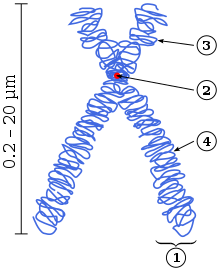Centromere
| Parent |
| chromosome |
| Subordinate |
| α / β- heterochromatin kinetochore protein complexes |
| Gene Ontology |
|---|
| QuickGO |

1 chromatid, 2 centromere,
3 short arm (p-arm), 4 long arm (q-arm).
> Not marked: four telomeres
As a centromere or centromere (from ancient Greek κέντρον kentron , center 'and μέρος meros , Part') refers to the area of the primary constriction (constriction) of a metaphase - chromosome . Here the two chromatids are related until they are separated during nuclear division ( mitosis or second meiotic division) at the beginning of the anaphase : The fibers of the spindle apparatus attach to the protein complexes that form on the centromere, the kinetochores , which the sister chromatids to the opposite ones Pull cell poles. The centromere divides each chromatid into two arms, the lengths of which often differ significantly.
Likewise, in the centromeric area of the chromatid chromosomes, the cohesin (the protein that holds the chromosome together) is never removed until the prophase of mitosis.
history
The technical term was coined in 1903 by the anatomist Wilhelm Waldeyer , who invented the term chromosome in 1888 .
literature
- Bruce Alberts , Alexander Johnson, Julian Lewis, Martin Raff, Keith Roberts, Peter Walter: Molecular Biology of the Cell , 5th Edition, Garland Science, Taylor & Francis Group 2008, ISBN 978-0-815341062 , pages 228-230.
- Donald Voet, Judith G. Voet: Biochemistry. 4th edition, John Wiley & Sons, New York 2011, ISBN 978-1-11813992-9 . Pp. 20, 24, 109, W53, W55, W66
Individual evidence
- ↑ Rigomar Rieger, Arnd Michaelis, Melvin M Green: A glossary of genetics and cytogenetics: Classical and molecular. Springer: Berlin, Heidelberg, New York 1968, there p. 49.